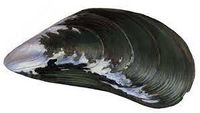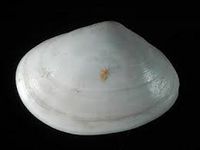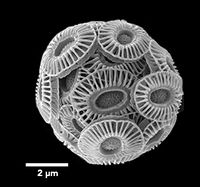Ocean acidification
Definition of Ocean acidification:
The process whereby atmospheric carbon dioxide dissolves in seawater producing carbonic acid, which subsequently lowers pH of surrounding seawater; widely thought to be happening on a global scale.
This is the common definition for Ocean acidification, other definitions can be discussed in the article
|
This article presents the results of studies on the impact of ocean acidification on a few common calcifying marine organisms.
A more complete introductory article on ocean acidification can be found in the Wikipedia: Ocean acidification.
Contents
Ocean acidity
The unit for measuring ocean acidity is the pH. pH is a measure of hydrogen ion [math]H^+[/math] activity. It is estimated from the approximate formula
[math]pH \approx - log_{10} ([H^+]) ,[/math]
where [math][H^+]= c_{eq}(H^+)[/math] is the equilibrium concentration (measured in number of moles per liter) of [math]H^+[/math] ions at a given temperature ([math]25 ^oC[/math]). A solution is neutral if [math]pH=7[/math], acidic if [math]pH\lt 7[/math] and basic if [math]pH\gt 7[/math].
The average acidity of ocean surface waters was [math]pH=8.15[/math] in pre-industrial times. Due to the increase in the atmospheric CO2 concentration, the amount of CO2 dissolved in the ocean has also increased. It is estimated that about 30% of the yearly emitted CO2 is absorbed by the oceans[1]. The uptake of CO2 has raised the acidity of the ocean surface waters in 2020 to about [math]pH=8.05[/math]. This is equivalent to an increase of hydrogen ion activity of about 26%.
The average acidity of ocean surface waters is expected to decrease by 0.14–0.43 units (i.e., a decrease in pH from about 8.15 to about 7.7 - 8) with a concurrent increase of +2 oC and +4 oC in sea surface temperature by 2100[2].
Ocean acidification is not only due to uptake of atmospheric CO2. Other processes also contribute to acidification, especially in eutrophic coastal waters: decomposition of organic material, nitrification in surface water (promoted by sewage discharge) and oxidation processes in sediments[3].
Influence on calcifying organisms
The dissolution of CO2 in water corresponds to the chemical balances
[math]CO_2+H_2O \rightleftharpoons H_2CO_3 \rightleftharpoons HCO_3^- + H^+ \rightleftharpoons CO_3^{2-} +2H^+ .[/math]
The increasing concentration of free hydrogen ions decreases the pH thus increases the acidity. As part of the hydrogen ions combine with carbonate ions [math]CO_3^{2-}[/math] to form bicarbonate [math]HCO_3^-[/math], fewer carbonate ions remain available for marine calcifying organisms to produce calcium carbonate [math]CaCO_3[/math] shells. The solubility of calcium carbonate increases when the saturation state decreases. The saturation state of calcium carbonate decreases with decreasing concentration of carbonate ions. It also decreases with increasing depth, which explains why calcifying organisms do not occur at great depths in the ocean.
Calcium carbonate in the oceans occurs in two crystalline forms (polymorphs), aragonite and calcite. Aragonite is much more soluble than calcite. Organisms that produce aragonite are therefore more vulnerable to changes in ocean acidity than those that produce calcite.
Influence of ocean acidification on a few bivalve species
Oyster Magallana gigas and mussel Mytilus spp.
Mytilus spp. and Magallana gigas together account for almost half of global mollusc production within the aquaculture industry. As the ocean’s pH decreases, the extent of the effect of ocean acidification is dependent on the shell structure and composition of the organism. Both the mussel Mytilus species (spp.) and the oyster Magallana gigas form calcite layers, but Mytilus spp. also forms aragonite on the inner shell layer. Although the two polymorphs share the same chemical formula, the different atomic arrangement of aragonite increases susceptibility to ocean acidification, compared to calcite.
Experiments were conducted to examen the interactive effects on Mytilus spp. and Magallana gigas of pH (8.1 versus 7.7), temperature (12 versus 14 oC) and feeding (control versus extra feed) in a full factorial experimental design. The following observations were reported (Mele et al., 2023[4]):
"When seawater temperature rises, Mytilus spp. appear to rely on metabolically sourced carbon for shell calcite potentially from extrapallial fluid (fluid from outside the mantle) rather than from mantle tissue or from the feed under ocean acidification. The altered biomineralization pathway in Mytilus spp. into the shell calcite layer, is sufficient to maintain the growth of the shell, as well as its thickness and hardness. On the other hand, Mytilus spp. increases environmentally sourced carbon for aragonite under low pH conditions. This response is sufficient to maintain and increase shell thickness in high water temperature scenarios. Low pH also affects M. gigas from a feeding and nutrient perspective shown by variation in mantle nitrogen isotopes, but biomineralization pathway is maintained along with growth.
Previous research has shown that increasing food supply to mollusks during ocean acidification experiments can limit shell corrosion and increase shell growth. However, plankton blooms would be more beneficial to M. gigas, as this study shows overall better shell performance and resilience than Mytilus spp."
White furrow shell Abra alba
A study of Vlaminck et al. (2022[5]) on the physiological response of the white furrow shell Abra alba to three pH treatments (pH = 8.2, pH = 7.9 and pH = 7.7) showed no pH effect on survival.
"However, lowered respiration and calcification rates, decreased energy intake (lower absorption rate) and increased metabolic losses (increased excretion rates) occurred at pH ∼ 7.7. These physiological responses resulted in a negative Scope for Growth and a decreased condition index at this pH. This suggests that the physiological changes may not be sufficient to sustain survival in the long term, which would undoubtedly translate into consequences for ecosystem functioning."
Peruvian scallop Argopecten purpuratus
Along the Peruvian coast, natural conditions of low pH (7.6–8.0) are encountered in the habitat of the Peruvian scallop Argopecten purpuratus, due to the nearby coastal upwelling. During 28 days, scallops (initial mean height = 14 mm) were exposed to two contrasted pH conditions: a control with unmanipulated seawater presenting pH conditions similar to those found in situ (pH = 7.8) and a treatment, in which CO2 was injected to lower the pH to 7.4.
"At the end of the experiment, shell height and weight, and growth and calcification rates were reduced about 6%, 20%, 9%, and 10% respectively in the low pH treatment. Mechanical properties, such as microhardness were positively affected in the low pH condition and crushing force did not show differences between pH treatments. Final soft tissue weights were not significantly affected by low pH. This study provides evidence of low pH change shell properties increasing the shell microhardness in Peruvian scallops, which implies protective functions" (Cordova-Rodriguez et al., 2022[6]).
Influence of ocean acidification on coccolithophores
Coccolithophores are unicellular organisms belonging to the marine phytoplankton community. The most common species is Emiliania huxleyi, ubiquitous in temperate, subtropical and tropical oceans. Coccolithophores are covered with calcium carbonate scales called coccoliths. Coccoliths from dead coccolithophores contribute to the ocean's carbon sink. Coccolithophores account for about 10% of carbon export and comprise a major fraction of carbonate in ocean sediments, ranging from 30% to 90%.
Krumhardt et al. (2019[7]) studied the sensitivity of coccolithophore growth and calcification to increasing CO2 both regionally and on a global scale using the Community Earth System Model (CESM) version 2.0[8]. This model was validated by comparison with satellite-derived ocean data of particulate inorganic carbon, a compilation of coccolithophore biomass estimated from shipboard measurements, a global compilation of coccolithophore calcification rates and estimates of globally integrated annual upper ocean calcification rates.
The model results show that: "increasing CO2 stimulates the growth of coccolithophores in some regions (North Atlantic, Western Pacific, and parts of the Southern Ocean), allowing them to better compete for resources with other phytoplankton functional types in the model. As CO2 increases in the upper ocean, however, calcification is impaired. Most regions of the ocean show vast declines in pelagic calcification, with some regions (in the Southern Ocean and North Pacific) being subject to almost no calcification by coccolithophores at end-of-the-century CO2 levels. Though CO2 stimulates growth in some areas, coccolithophores in general are projected to be more lightly calcified under future, high CO2 conditions.
See also
Review on the impacts of ocean acidification by Kroeker et al. (2014[9]).
References
- ↑ Terhaar, J., Froelicher, T.L. and Joos, F. 2022. Observation-constrained estimates of the global ocean carbon sink from Earth system models. Biogeosciences 19: 4431–4457
- ↑ Lee, J.-Y., Marotzke, J., Bala, G., Cao, L., Corti, S., Dunne, J.P., Engelbrecht, F., Fischer, E., Fyfe, J.C., Jones, C., Maycock, A., Mutemi, J., Ndiaye, O., Panickal, S. and Zhou, T. 2021. Chapter 4: Future Global Climate: Scenario-Based Projections and Near- Term Information. In Climate Change 2021: The Physical Science Basis. Contribution of Working Group I to the Sixth Assessment Report of the Intergovernmental Panel on Climate Change. Cambridge University Press, pp. 553–672
- ↑ Wallace, R.B. and Gobler, C.J. 2021. The role of algal blooms and community respiration in controlling the temporal and spatial dynamics of hypoxia and acidification in eutrophic estuaries. Marine Pollution Bulletin 172, 12908
- ↑ Mele, I., McGill, R.A.R., Thompson, J., Fennell, J. and Fitzer, S. 2023. Ocean acidification, warming and feeding impacts on biomineralization pathways and shell material properties of Magallana gigas and Mytilus spp. Marine Environmental Research 186, 105925
- ↑ Vlaminck, E., Moens, T., Vanaverbeke, J. and Van Colen, C. 2022. Physiological response to seawater pH of the bivalve Abra alba, a benthic ecosystem engineer, is modulated by low pH. Marine Environmental Research 179, 105704
- ↑ Cordova-Rodríguez, K., Flye-Sainte-Marie, J., Fernandez, E., Graco, M., Rozas, A. and Aguirre-Velarde, A. 2022., Effect of low pH on growth and shell mechanical properties of the Peruvian scallop Argopecten purpuratus (Lamarck, 1819). Marine Environmental Research 177, 105639
- ↑ Krumhardt, K. M., Lovenduski, N. S., Long, M. C., Levy, M., Lindsay, K., Moore, J. K. and Nissen, C. 2019. Coccolithophore growth and calcification in an acidified ocean: Insights from community earth system model simulations. Journal of Advances in Modeling Earth Systems 11: 418-1437
- ↑ Marine Biogeochemical Library (MARBL), https://marbl-ecosys.github.io/
- ↑ Kroeker, K.J., Kordas, R.L., Crim, R., Hendriks, I.E., Ramajos, L., Singh, G,S, Duartes, C.M. and Gattusa, J-P. 2014. Impacts of ocean acidification on marine organisms: quantifying sensitivities and interaction with warming. Global Change Biology 19: 1884–1896, doi: 10.1111/gcb.12179. https://onlinelibrary.wiley.com/doi/epdf/10.1111/gcb.12179
Please note that others may also have edited the contents of this article.
|




